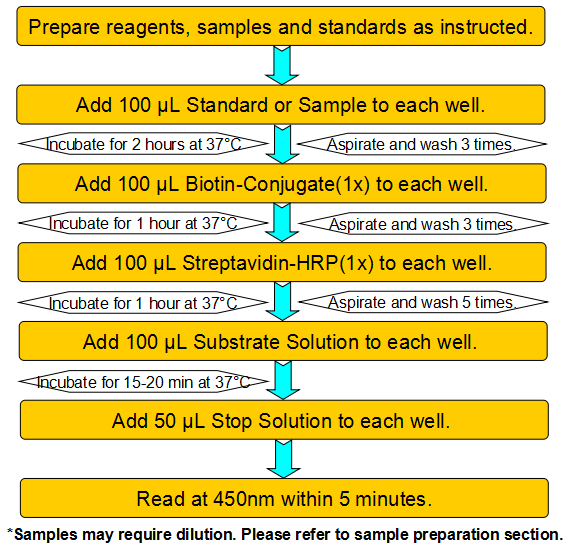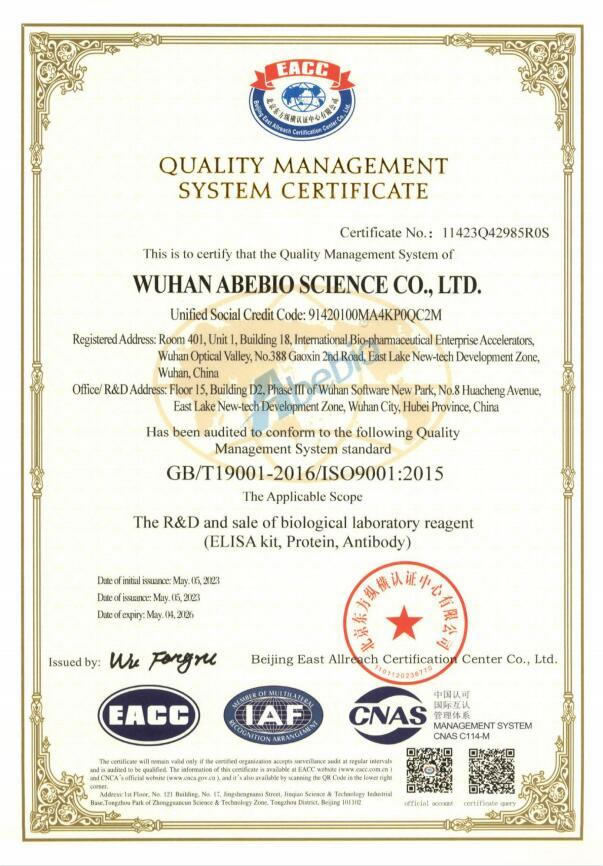Product Details
| Species Reactivity |
General |
| UniProt |
N/A |
| Abbreviation |
E2 |
| Alternative Names |
N/A |
| Range |
Request Information |
| Sensitivity |
Request Information |
| Sample Type |
Serum, Plasma, Other biological fluids |
| Detection Method |
Competitive |
| Analysis Method |
Quantitive |
| Assay Duration |
1-4.5h |
| Sample Volume |
1-200 μL |
| Detection Wavelengt |
450 nm |
Test principle
This assay employs the competitive enzyme immunoassay technique. The microtiter plate provided in this kit has been pre-coated with goat-anti-rabbit antibody. Standards or samples are added to the appropriate microtiter plate wells with an antibody specific for E2 and Horseradish Peroxidase (HRP) conjugated E2. The competitive inhibition reaction is launched between with HRP labeled E2 and unlabeled E2 with the antibody. A substrate solution is added to the wells and the color develops in opposite to the amount of E2 in the sample. The color development is stopped and the intensity of the color is measured.
Product Overview
Estradiol is an estrogenic hormone, C18H24O2, produced by the ovaries and used in treating estrogen deficiency. Estradiol is essential for maintaining normal female functions and is normally produced by the ovaries. After menopause, the ovaries decrease their production of this hormone.
Estradiol is a sex hormone. Estradiol is the predominant sex hormone present in females; however, it is present in males, albeit at lower levels, as well. It represents the major estrogen in humans. Estradiol has not only a critical impact on reproductive and sexual functioning, but also affects other organs including the bones.Estradiol is produced not only in the gonads: In both sexes, precursor hormones, to be specific testosterone, are converted by aromatization to estradiol. In particular, fat cells are active to convert precursors to estradiol, and will continue to do so even after menopause.
Components
|
Reagents
|
Quantity
|
Reagents
|
Quantity
|
|
Assay plate (96 Wells)
|
1
|
Instruction manual
|
1
|
|
Standard
|
6 x 1 mL
|
Antibody
|
1 x 6 mL
|
|
HRP-Conjugate
|
1 x 6 mL |
Wash Buffer (concentrate 20 x) |
1 x 15 mL |
|
Substrate A
|
1 x 7 mL |
Substrate B |
1 x 7 mL |
|
Stop Solution
|
1 x 7 mL
|
Adhesive Films
|
4
|
Specificity
This assay has high sensitivity and excellent specificity for detection of E2. No significant cross-reactivity or interference between E2 and analogues was observed.
Recovery
Matrices listed below were spiked with certain level of recombinant E2 and the recovery rates were calculated by comparing the measured value to the expected amount of E2 in samples.
Precision
Intra-assay Precision (Precision within an assay)
Three samples of known concentration were tested twenty times on one plate to assess intra-assay precision.
Inter-assay Precision (Precision between assays)
Three samples of known concentration were tested in forty separate assays to assess inter-assay precision.
CV (%) = SD/meanX100
Intra-Assay: CV<8%
Inter-Assay: CV<12%
Linearity
The linearity of the kit was assayed by testing samples spiked with appropriate concentration of E2 and their serial dilutions. The results were demonstrated by the percentage of calculated concentration to the expected.
Stability
The stability of ELISA kit is determined by the loss rate of activity. The loss rate of this kit is less than 5% within the expiration date under appropriate storage condition. The loss rate was determined by accelerated thermal degradation test. Keep the kit at 37°C for 4 and 7 days, and compare O.D.values of the kit kept at 37°C with that of at recommended temperature. (referring from China Biological Products Standard, which was calculated by the Arrhenius equation. For ELISA kit, 4 days storage at 37°C can be considered as 6 months at 2 - 8°C, which means 7 days at 37°C equaling 12 months at 2 - 8°C).
Sample collection and storage
Serum: Use a serum separator tube (SST) and allow samples to clot for two hours at room temperature or overnight at 2 - 8°C before centrifugation for 15 minutes at 1000 × g. Remove serum and assay immediately or aliquot and store samples at ≤ -20°C. Avoid repeated freeze-thaw cycles. Plasma: Collect plasma using EDTA, or heparin as an anticoagulant. Centrifuge for 15 minutes at 1000 × g at 2 - 8°C within 30 minutes of collection. Assay immediately or aliquot and store samples at ≤ -20°C. Avoid repeated freeze-thaw cycles. Other biological fluids: Centrifuge samples for 20 minutes at 1000 × g. Remove particulates and assay immediately or store samples in aliquot at -20°C or -80°C. Avoid repeated freeze/thaw cycles.
Kits storage instructions
Store at 2-8°C. Please refer to Instruction Manual.



